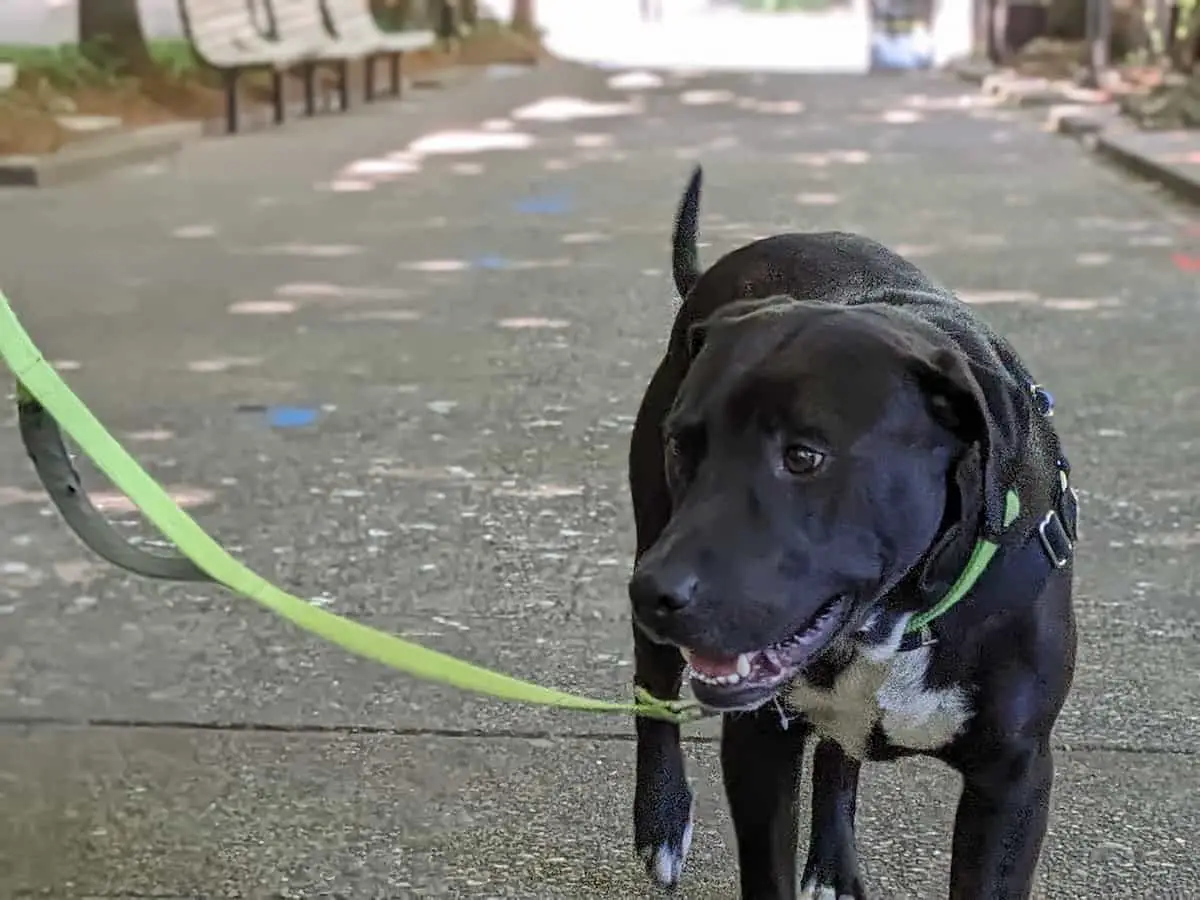Want your pup to be a leash-walker? Whether your furry friend is young or older, training a dog to walk on a leash isn’t as simple as grabbing a leash and heading out the door.
Leash-walking is a skill that your dog has to learn. It requires patience on your part, but you’ll develop a stronger bond, and go on to make many memories on future walks with your best friend.
Keep reading to learn the ins and outs of training a dog to walk on a leash.
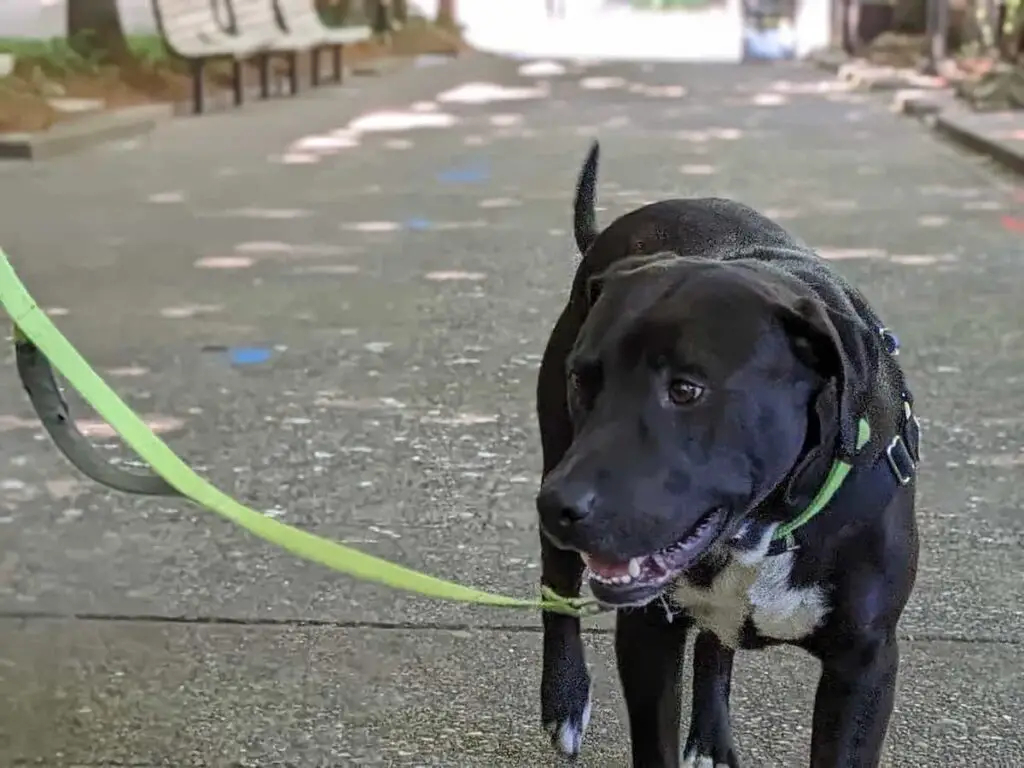
Reward-Based Training
You should expect treats to be involved when training a dog to walk on a leash. Using treats is a form of reward–based training, or teaching your dog new behaviors by rewarding them with things they like. Rewards may entail treats, toys, or games, as well as pets and praise.
Treats are among the easiest rewards to administer when training a dog to walk on a leash. You can give them to your dog periodically as he or she follows directions. Because dogs will always look forward to receiving treats, it’s a great way to express a job well done and to reinforce desired behaviors.
Certainly, you’ll want to choose smaller treats for dog leash-training, like Zuke’s Mini Naturals Peanut Butter & Oats Training Treats or Blue Buffalo Blue Bits Tender Beef Recipe Soft-Moist Training Treats. You can use bite-sized treats to reward your dog periodically without compromising their health.
Important Reminders
When you’re training a dog to walk on a leash, it’s important that your dog feels comfortable. If they feel hurried or rushed, they’re more likely to lose interest or view the experience as negative. Your pup is about to em-”bark” on a new experience, after all, and it’s one they’ll need time to prepare for.
Refrain from using harsh tones or commands. Instead, enforce discipline through consistency and firmness, and take breaks as needed.
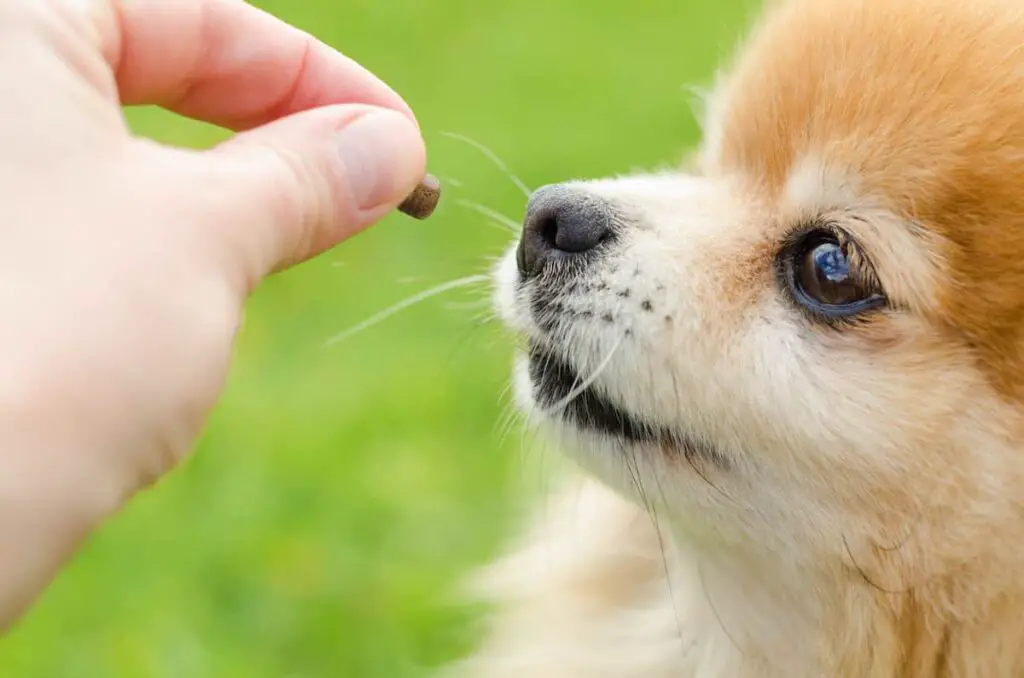
Prepping Your Pup For What’s Ahead
You can start training a dog to walk on a leash when they are eight weeks old. However, patience is key, no matter how old your dog is.
Before you go outdoors, you’ll want to start training inside. Choose a quiet environment with few distractions, and one that your dog feels safe in. Make sure you aren’t distracted either, because you’ll need to give your pup your full attention. Puppies, especially, don’t have long attention spans, so it’s important to remain present.
Here are eight steps to training a dog to walk on a leash.
Step 1: Choose the Right Leash
As mentioned, your dog’s comfort is key. Their comfort not only pertains to their environment, but also to their collar, leash, and harness, if you use one.
Be sure to choose a leash that’s appropriate for their size and breed. Thinner leash styles work best for smaller dogs that aren’t likely to use much force when pulling. Thicker leashes are ideal for larger breeds.
Step 2: Introduce the Dog Collar and Leash
After you’ve chosen the appropriate dog collar and leash, you’ll want to introduce your pup to them. Allow your dog time to sniff out these items and get acclimated, just as they would with a new visitor. Then, put the collar on your pup and have them wear it indoors. After a day or so, attach the leash to the collar, and give them time to adjust.
Watch your pup closely and see how they react. Use this step as an opportunity to really ensure that your dog is comfortable. Perform this routine a few times. When your dog wears the collar and leash indoors, offer them treats for a job well done.
Step 3: Use a Signal
Ahead of training a dog to walk on a leash, you’ll need to decide on a cue, such as word, phrase, sound, or hand signal. Some owners prefer to use the word “yes” or “good,” cluck their tongue, or use a thumb’s up to attract their dog’s attention. Whichever cue you use, make sure it remains consistent. You can also use a dog-training clicker for this, which is also a method that relies on positive reinforcement.
While your dog is wearing the collar and leash, signal the cue. The moment your furry friend looks at you, reward them with a treat. After repeating this step a few times, your dog will begin associating the cue with a treat, and approach you on their own.
Step 4: Teach Your Dog To Come To You
An essential part of training a dog to walk on a leash, is teaching them to come to you. When you graduate to taking your dog on walks, there will be distractions in the form of new sights, sounds, smells, and even other dogs. You’ll need to direct your dog’s attention elsewhere in these instances to prevent them from pulling, lunging, and pouncing. The fundamental part of this process begins with teaching your dog to come to you.
While your dog is wearing their collar and leash, encourage them to walk in your directions. Each time they take a step or two towards you, reward them with a treat. After a few repeat instances, start taking a few steps back so your dog has to walk further. When they reach you, reward them with a treat.
Perform this routine for 10 to 15 minutes a day, until your dog becomes acclimated.
Step 5: Practice Walking Indoors
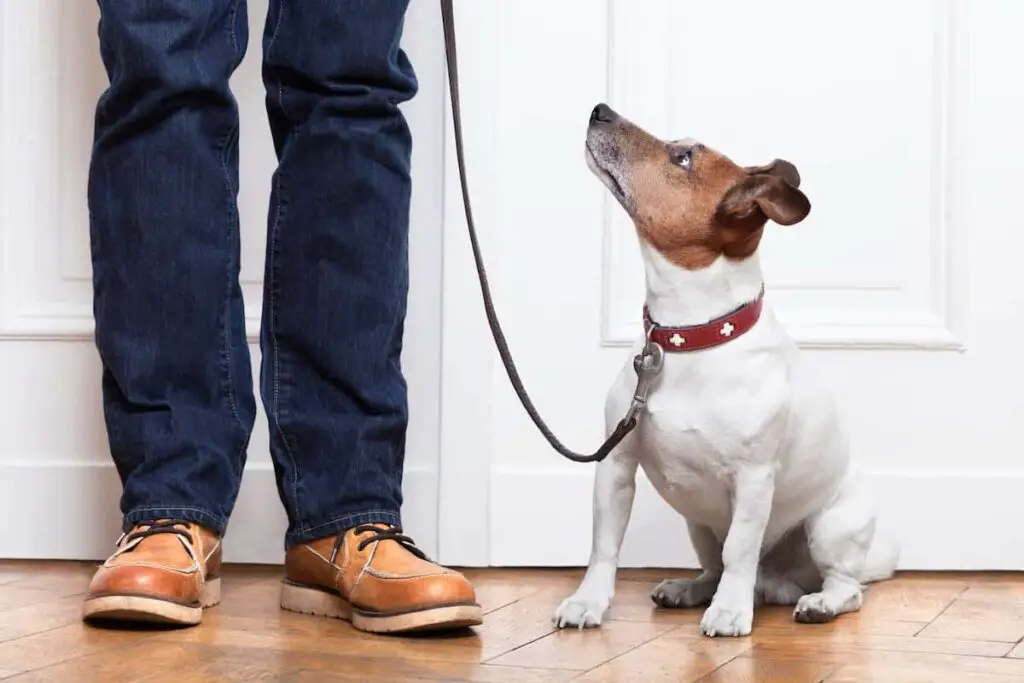
Now that your dog has adjusted to their collar and leash, and has started responding to your commands, you can try going for “walks” indoors. See how your pup reacts when you hold the leash and take the lead. Encourage them to keep pace and use treats as positive reinforcement throughout. Use this step as an opportunity to gauge your dog’s progress and comfort level.
Continue practicing this step indoors, also for 10 to 15 minutes a day, until your dog seems comfortable with the process. Remember to have patience!
Step 6: Feed Them Treats On One Side
With your pup now walking around the house with you, it’s time to direct them to one side. Another important part of training a dog to walk on a leash, is training them to remain situated on one side of you. Most dog-walkers prefer the left side, but you can choose whatever side works best for you.
This step is to prevent your dog from circling you and weaving in and out of your legs during walks. Weaving causes the leash to become tangled in your legs, and can put you at a risk of falling–yikes!
To start, begin by giving your dog a treat only when they stand on a specific side. Use the cue to attract their attention. After a few times of doing so, your dog will associate this designated side with treats.
Step 7: Start Randomizing Treats
Once your dog gets into the rhythm of walking on a leash, begin alternating the amount of times they receive a treat. You can offer them treats at every second step, then every third step, fourth step, and so on. The randomness will keep your pet engaged and also ensure they aren’t consuming too many treats!
Treats are used more frequently as you go through the steps of training a dog to walk on a leash. Once your pup has learned the ropes, you won’t need to use treats to guide your dog through each step.
Step 8: Take it Outside

With enough practice under you and your pup’s belts, it’s time to take leash-walking outdoors. Keep in mind that your dog will be somewhat distracted at first, because they are taking in a environment. It’s not unlikely for a pup to focus their eyes on a bird or squirrel, or another dog. However, if it’s possible, we suggest that you practice in your own yard space, or in an area without much distraction.
When training a dog to walk on a leash outdoors, your first few walks should be short. After they adjust to this initial change, you can gradually increase the distance over time. Try breaking up the distance into different brackets. For example, start in your front or backyard, then go to the end of your driveway, and then to the nearest street lamp or stop sign, the end of the street, and so on.
Every now and then, start walking and signal the cue to see if your dog comes to you. When they do, reward them with another treat.
Possible Challenges When Training A Dog To Walk On A Leash
Even when your dog becomes a seasoned leash-walker, you’ll experience hiccups every now and then. It could be that your dog is having an “off” day–yes, just like humans do!–or they are distracted.
Here are some common issues to look out for when training a dog to walk on a leash, and how to remedy them.
Barking
Some breeds, like chihuahuas, beagles, bloodhounds, and German shepherds, bark louder and more often than other breeds. It’s also common for dogs to bark when they approach other dogs, especially when it’s a new experience.
Dogs may bark to communicate, show affection, or convey their territory. Barking may also be associated with a lack of exercise.
When training a dog to walk on a leash, you can attempt to curb barking behaviors by ensuring they have enough physical exercise for their age and breed. If your dog continues to bark while walking, try to redirect them with treats. Doing so also gives you the opportunity to create space between your dog and whatever they’re barking at.
Leash-Pulling
It’s common to see dog-owners, especially new ones, being pulled by their dog’s leash. If this happens to you, don’t simply go along with it. Instead, assume the stance of a tree.
Keep your body very still and do not move with your dog until they return to you. Do not be aggressive with the leash, and refrain from harsh pulling or yanking. Doing so will teach your dog that pulling you in a certain direction will not allow them to arrive at their destination any sooner.
If your dog is a frequent leash-puller, there are specialty harnesses, such as head halters and front-hook harnesses, that you can use.
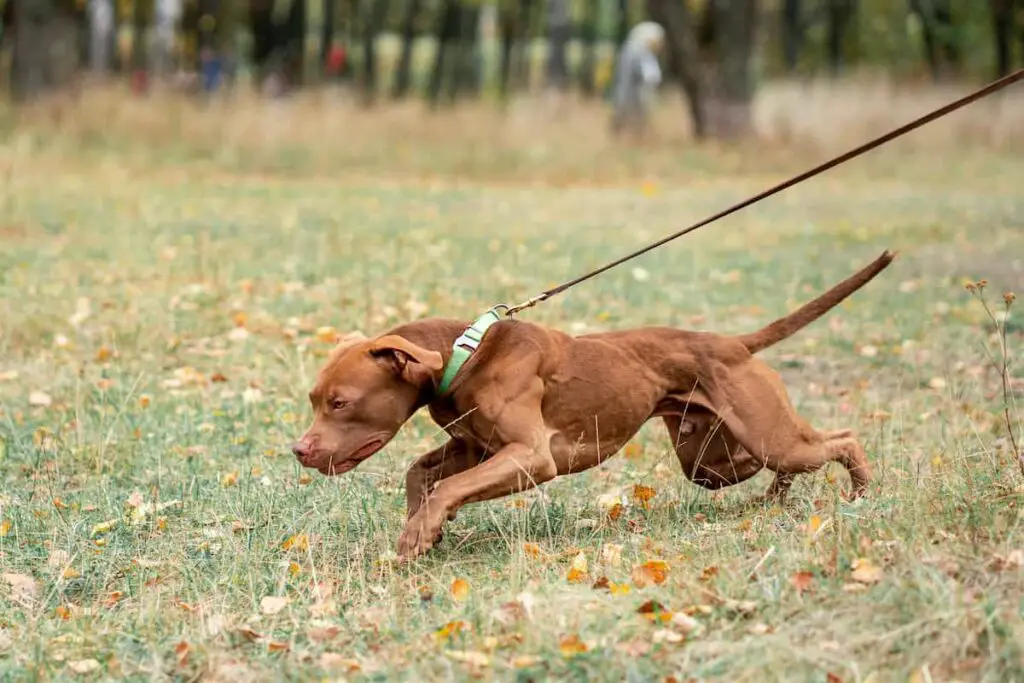
Lunging and Chasing
With all the distractions out there, there’s a good chance your dog will lunge or chase something at some point. If this happens while training a dog to walk on a leash, you can also assume the “tree” stance and keep still. Refrain from pulling or yanking on their leash, and instead call your dog’s name in an upbeat voice while also signaling the cue.
Once you have your dog’s attention, reward them with a treat and start increasing the space between your dog and their intended target. You may continue to lead them away with treats until the distraction dissipates.
If this effort doesn’t work, then gently–and we mean gently–pull on your dog’s leash and direct them away. Hold the leash firmly at your belly and take consistent strides in your intended direction. Face your body and direct your gaze towards this direction. If you don’t give your dog leeway to believe they’re the leader, you’ll be able to gain the upper hand.
Biting The Leash
It’s possible, when training a dog to walk on a leash, that you’ll notice that your dog is a biter. If your dog has a tendency to bite their leash, there’s one important rule to follow: do not tug the leash away! If you do so, your dog will think you’re playing a game of tug-of-war and it’ll excite them.
Instead, move the leash toward your dog to create more slack and release tension. The tension, after all, is what your dog is after. When your dog drops the leash, reward them with a treat. If this still doesn’t work, you may decide to use two leashes: one for biting and one for walking.
Training a Dog on a Leash: Frequently Asked Questions

What is the best age to leash-train a dog?
Puppies can begin to understand commands at eight weeks old. As soon as you bring your pup home, or when they reach this age, it’s safe to start teaching them how to walk on a leash. However, despite the old saying that “you can’t teach an old dog new tricks,” training a dog to walk on a leash is possible at any age. The process may just take a little bit longer with an older dog.
How long does it take a dog to learn how to walk on a leash?
Training a dog to walk on a leash takes about four to six weeks. The true amount of time will vary depending on your dog’s age, personality, and preferences.
Train Your Dog To Be A Leash-Walker In No Time
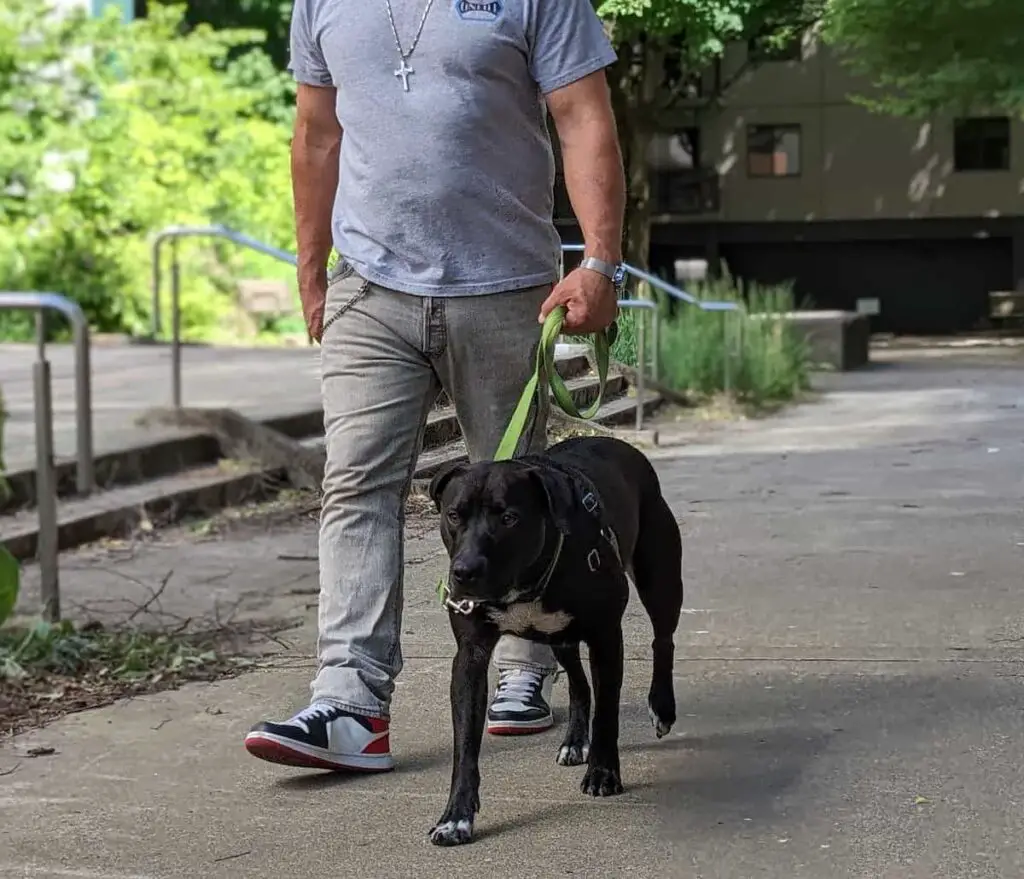
Training a dog to walk on a leash takes time, patience, and dedication. However, it’s a much-needed skill that provides exercise and adventure for your dog–and for you, too!
Once your dog becomes comfortable with the basics, and leash-walking develops into a habitual activity, you can take your pup on longer walks, hikes, and trips. Want to know perfect treats to use when training your dog to be a leash-walker? Check out our page on The 5 Best Dog Training Treats to learn more!

